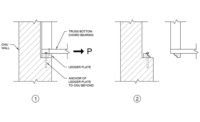Following the Minnesota Bridge collapse, California Department of Transportation (Caltrans) conducted safety inspections of all bridges similar in design type to the I-35W Bridge, says department spokesman David Anderson. All California steel deck truss structures were found to be safe.
Anderson adds that when new information from the investigation of the collapse pointed to a design flaw rather than an inspection issue, Caltrans initiated an ongoing review of all bridges of similar design to the I-35W structure, to identify any changes that could overload a structure and potentially compromise its load-carrying capacity. No California bridges were closed as a result of the review.
Caltrans has received an additional $100 million in dedicated federal bridge funding from the omnibus spending bill enacted last December. These new funds will be used to address bridge rehabilitation or replacement needs identified in the State Highway Operations and Protection Program (SHOPP).
Anderson says that Caltrans conducts more than 12,000 bridge inspections each year, in accordance with provisions in the Code of Federal Regulations. In addition to these annual inspections, in 2007 Caltrans conducted inspections on all steel deck truss bridges in the state, in accordance with a Federal Highway Administration technical advisory issued soon after the I-35W Bridge collapse.
No emergency spending was proposed in California on bridges in the past year related to the collapse of the I-35W Bridge, Anderson says. The California Transportation Commission, however, did approve the use of GARVEE bonding to replace of four large bridges. The four bridge replacements were planned before the collapse of the Minnesota bridge, he says.
Few reverberations from the Minnesota bridge collapse were felt in California, partly because of more-stringent inspection processes and necessary seismic retrofits. State officials were completing a 10-year seismic retrofit of the state's bridges at the time of the Minnesota bridge collapse, Caltrans officials say.
Dealing with public perception was one of the main issues resulting from the Minnesota bridge collapse, says Edward Cartagena, spokesman for the Caltrans San Diego district. "Everyone would call and report when they saw a crack," Cartagena recalls. "We handled those questions a few months afterward."
Bridge design has not undergone any fundamental changes in California since the Minnesota collapse, says David Goodyear, senior vice president and chief bridge engineer for North American operations for infrastructure consulting firm T.Y. Lin International. Part of the reason is that Caltrans has a highly structured, disciplined design review process already in place, he says.
Unlike many jurisdictions in the U.S., Caltrans does a totally independent review of bridges, Goodyear says. In the Caltrans review, an independent party not associated with the bridge design reviews the bridge and does not look at the original plans and computations, he says.
In other jurisdictions, an independent party will use those plans and computations when doing their bridge review, he says. Under that method, "You tend to be drawn into the original designer's way of thinking," Goodyear says. The Caltrans independent review of bridges is a more standardized process that we could see more of throughout the U.S., he says. "In my opinion, it's it's more thorough," Goodyear says.
 Related Links:
Related Links: 

Post a comment to this article
Report Abusive Comment